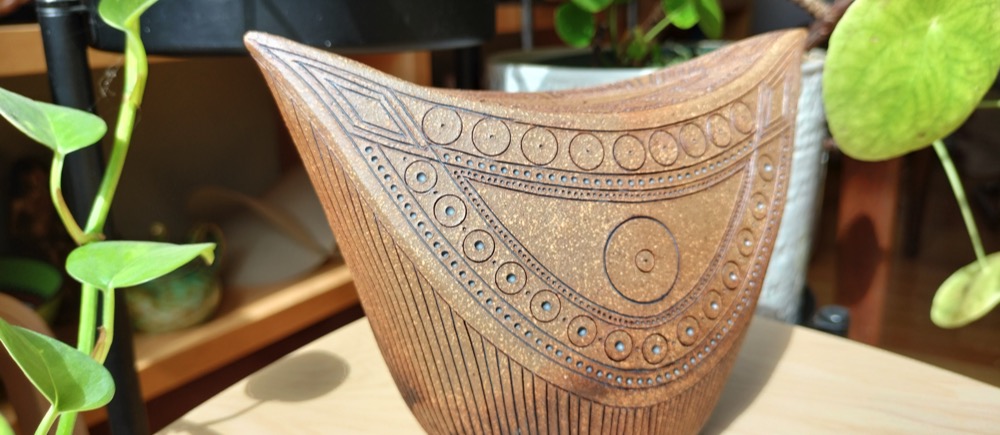
A NON-VERBAL DISCOURSE WITH VISUAL ART
A NON-VERBAL DISCOURSE WITH VISUAL ART
We each express this creative exigent power to communicate, whether in an effort between individuals, groups, or within ourselves. To do this we often rely on language in the form of phonetics and linguistics, as in distinct sounds and grammars.
But there are other times when we get down deep into communication, and instead we rely on a unique symbolic framework of the senses. In addition to the concept of "body-language", this symbolic framework might be described as “a felt sense”.
Whether at a gallery standing before another artist's craft, or in the studio sitting with my clay, I find myself immersed in a world, or a sidled "realm” where color, shape, form, dimension, and time itself will harness the exigent powers of integral experience and imperative embodiment.
In its distinct way, art presents this inherency of creativity through this sensory discourse - as in, through this exchange of the felt symbolic framework. As I continue to exchange art, ideas, and feelings through this symbolic framework I am engaging this language of the senses. This sensory language is effectual and potential, and often discovered through the mutuality or reciprocity of a common mythicism.
The more I engage art as creative expression, the deeper it demonstrates the potential and effectuality of a sensory discourse.
...
To apply this heritage discourse in my art, I try to find sensory centers, or foci, around which our human ancestral lineage has engaged the mythic framework. I like to focus on example in which our species has learned to thrive, because it is a common heritage we all share. Some of these centers have developed a more common discourse, while others are still developing a discourse. For the most part, all of these centers have been intuited, investigated, and learned through our heritage past. They include, the shifting of visible light, as in daylight, or shadow, or under water, and as in night shifting into day; the changing of the seasons, weather, and climate; the movement of the celestial bodies across the plane of the ecliptic; the influence and impression of foods and fluids on our evolutionary heritage over the millennia, such as with clean water, or adaptogenic herbs and mushrooms; and the influence and impression of bacteria and viruses on our evolutionary heritage, over the millennia...
...
I also like to refer to these various focal centers because over a striking 2 million years, over the heritage of our evolutionary past, the human biological body has learned to use sensory input to self-regulate all of its complex and localized parts, as "a whole system". And from these base biological sensory values, quantifiable information is been coded in our genes and stored for future generations. This information has passed on through our DNA for so long, that each one of us today has personally grown up from the exponential genetic memory of billions of women and men, before us.
...
For example, there is the central focus on the effect and potential of light-value on the senses. From this sensory input of light, our bodies exercise powers of self-regulation in order to determine what activities we will engage in the daylight hours, and those activities of the nighttime hours. Sensory input includes the light-value of the sun (our closest star) compared to the light-value of the moon, the planets, or the distant stars. It also includes the light value of the color spectrum. Humans can see more values of the color green than any other color. Evolutionary scientists and systems thinkers have theorized that our bodies developed this "super sense" to better distinguish edible plants.
...
Accompanying this sensory experience, our species has developed a profoundly influential mythic framework to harness and expand our engagement with sensory and verbal discourse. This mythic framework describes and investigates the fields of health, style, cultural practice and resource cultivation, and it serves to organize concepts, communities, and discourse for our ability to not only survive, but thrive in the world.
...
Another example of a more common heritage mythicism comes from the ancient ancestral practice of watching the procession of the sun across the day sky, and the celestial bodies across the night sky - or the line these celestial bodies draw in the sky, over time. Today in astronomy, these movements are referred to as "the precession of the equinox" and "the plane of the ecliptic". From the dawn of the mortal-age, spanning back tens of thousands of years we have watched these cycles in order to track the calendar year, the lunar months, and the rise and passing of generations. Through crude to advanced calendar keeping, ancient societies learned from the repetition of the changing of the seasons, the changing of the tides, the effects of sunlight on the biosphere at various altitudes or in certain elemental conditions (dry deserts, wet ocean shores, dense forests, etc.), and many, many more geophysical influences and developments.
...
In simpler terms, the Precession of the Equinox refers to when the sun is highest in the sky in the summers, lowest in the sky in the winters, and in between these two locations in the springtime and autumn seasons. The Plane of the Ecliptic refers to the fixed path of the constellations and planets across the visible sky in the northern or southern hemispheres, and how the Earth rotates on its tilted axis and revolves around the central gravitational pull of the Sun, to display this cycle in certain hemispheres of the sky.
More coming soon... !
Sincerely,
EA Studio

